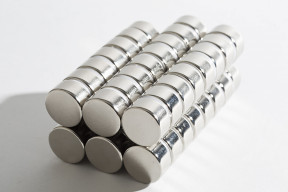A Column by Dr. Stan Trout
Several recent conversations have convinced me that as an industry, we are torn between two very distinct paradigms with respect to our use of heavy rare earths in sintered NdFeB magnets. Let’s call these paradigms Dysprosium 1.2 and Dysprosium 2.0, since we all seem to understand how the updates in computer software work. Let me describe each one, explain why I think we are clearly in the era of Dysprosium 2.0 and why it is a serious mistake not to upgrade our thinking.
Dysprosium 1.0 happened shortly after the introduction of sintered NdFeB magnets, circa 1983. We quickly learned that adding a few percent Dy to the alloy would give us as much coercivity as we wanted or thought we wanted. While there were small penalties to pay, higher cost and less available flux, the tradeoffs seemed very tolerable. At the time, it seemed like a very good deal.
Over the years we learned to use other alloying elements to at least partially achieve similar results. With the exception of terbium, we never completely got off our dependence on Dy, but we certainly reduced it. This was Dysprosium 1.1 and it lasted from about 1990 until 2005. We learned that terbium, dysprosium’s neighbor on the periodic table, actually works a bit better than dysprosium in increasing coercivity in sintered NdFeB magnets. However, Tb is usually less cost effective than Dy in this application. There have been times when it was the other way around, and terbium made more sense to use, due to their independent price fluctuations.
Dysprosium 1.2 began with the introduction of grain boundary diffusion technology (GBD) from several Japanese research organizations and suppliers, circa 2005. GBD is the result of a concerted effort to reduce the use of dysprosium, by roughly 50 percent. The premise of GBD is to introduce Dy primarily at the grain boundaries where it has the most beneficial effect on coercivity. Early on, the technology was met with a shrug, but as dysprosium prices rose, its wisdom was appreciated and people began to take advantage of this technology.
When the rare earth price spike occurred in 2010 to 2011, dysprosium was particularly hard hit. Both the height and duration of its peak were worse than light rare earths like neodymium. Strong demand was part of the story, but dysprosium has the additional constraint of not being particularly abundant in any of the World’s major rare earth ores. In short, there is no easy way to mine our way out of a dysprosium shortage.
Following the price spike, a new era, Dysprosium 2.0 has slowly emerged which contains five significant features:
- A search for more resources
- Increased interest in recycling
- Widespread application of Dy reduction technology, i.e. Dysprosium 1.2
- A search for new magnets without Dy
- Designs minimizing the use of Dy
One key take-away of Dysprosium 2.0 is that almost everyone has a homework assignment, meaning nearly everyone will find at least one thing on the list that they can do to help. It is important that we all grasp this point, because it is highly unlikely that any single approach mentioned above will resolve the problem completely by itself. There is no single “magic bullet.” To be successful, we need to fully explore all five possibilities, in the hope that some combination of these solutions will ease the pressure on dysprosium.
The difference between people living in Dysprosium 1.2 and Dysprosium 2.0 is complacency.
People living in Dysprosium 1.2 believe that they do not have to do anything differently; the geologists just need to find another heavy rare earth deposit. Furthermore, they believe that heavy rare earth prices will quickly and inevitably return to where they were a few years ago. Everything will go back to the way it was without too much trouble. In short, they have a big case of wishful thinking.
On the other hand, people living in Dysprosium 2.0 are taking all possible steps to address the five points on our list to make their future more secure. They are far from complacent. This is admittedly a more difficult path to follow; it takes more work. But the long term payoff is significant, much like Aesop’s Fable of the Ant and the Grasshopper.
I need to make special mention about point #5, which many people overlook. We must learn to design devices to use significantly less Dy. And we must update some older designs, at the same time. I believe this is the single most important thing that we as an industry can do in the short term to help with the dysprosium predicament we face today. How do we do that? In the early stages of design, a temperature range is selected for the device. The choice of the maximum temperature turns out to be the most significant decision in the material selection process because it determines the amount of Dy that is likely to be needed in a sintered NdFeB magnet. In addition, the choice of the maximum temperature is often done a bit carelessly, with little regard for the heavy rare earth consequences. If you enjoy studying magnet datasheets as I do, the connection between maximum temperature and Dy content is very clear, although it is rarely stated in this way. We really need to train an entire generation of designers to challenge the automatic selection of the maximum temperature and to be sure that it is selected wisely, i.e. no higher than absolutely necessary. This single change will lead to the selection of grades with the lowest possible Dy content that will do the job. This will be profoundly helpful because it is the best hedge against future heavy rare earth vulnerability.
How much dysprosium is too much? That is a difficult question to answer precisely because of the wide variety of applications and operating conditions. However, one holistic approach is to consider the ratio of dysprosium compared to neodymium and praseodymium that can be recovered annually. Using data from Dudley Kingsnorth’s 2009 report [1], we can crunch these numbers and convert the result into a magnet composition. We find a value of about 1.4 percent Dy in the alloy. This is a kind of tipping point, meaning that any design that uses more than this amount of Dy will likely not be tolerated in very large quantities without a significant price penalty [2]. Note that this approach assumes all the rare earths in question are used only in magnets. This isn’t true, but the idea of a tipping point in the neighborhood of 1.4 percent Dy is valid.
Let me finish by asking: are you living under Dysprosium 1.2 or have you upgraded to Dysprosium 2.0? Ask yourself which paradigm carries less risk if heavy rare earth prices spike again. If you haven’t already, I suggest that you consider upgrading to Dysprosium 2.0 as soon as possible.
References
[1] An Overview of the Rare Earths Market, Dudley J. Kingsnorth, IMCOA, November 2009
[2] Thanks to Steve Constantinides for first suggesting this approach.
 About the Author
About the Author
Dr. Stan Trout has more than 30 years experience in the permanent magnet and rare earth industries. Stan is a contributing columnist for Magnetics Business and Technology magazine and the Director of the Magnet Business for Molycorp Minerals, LLC. He can be reached at strout@ieee.org.
Reprinted from the Spring 2013 Issue of Magnetics Business & Technology



